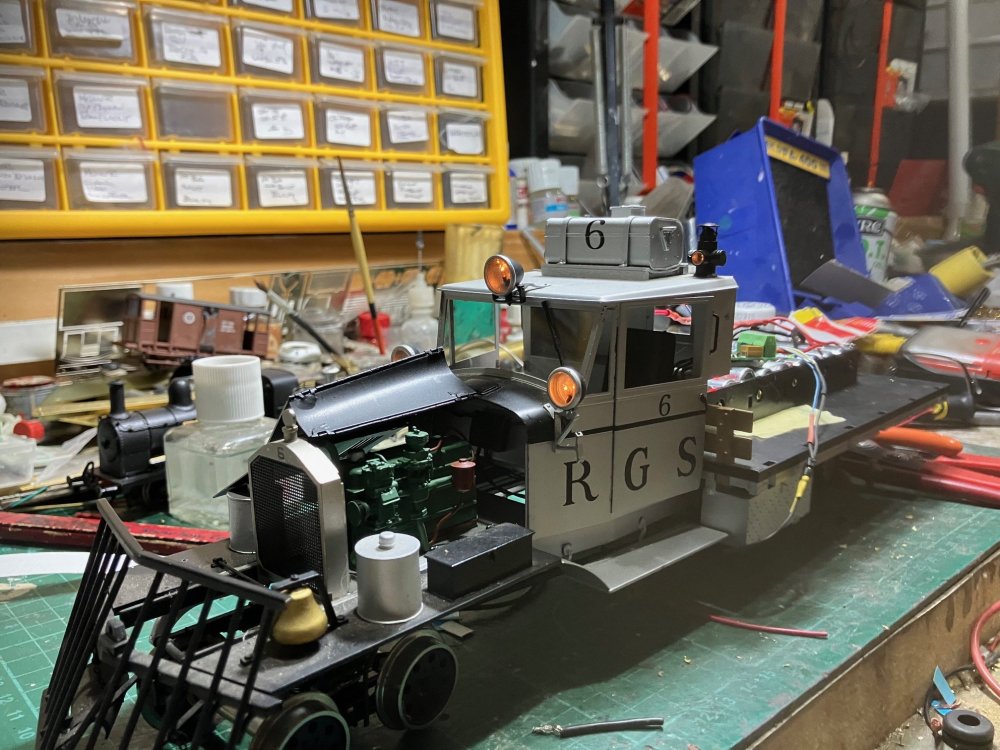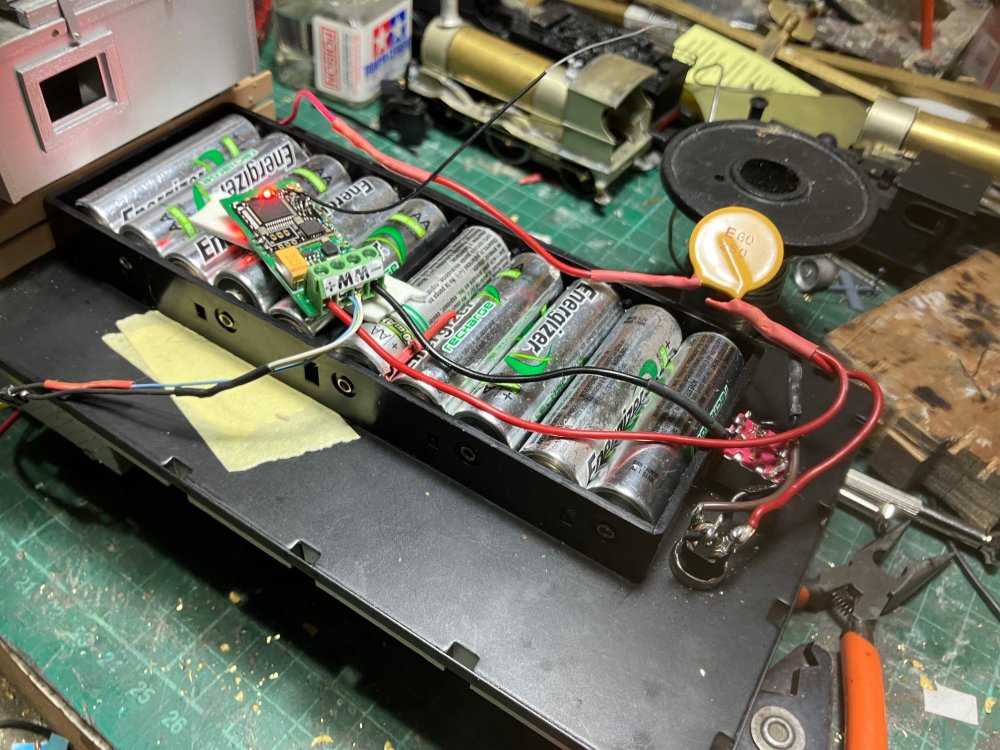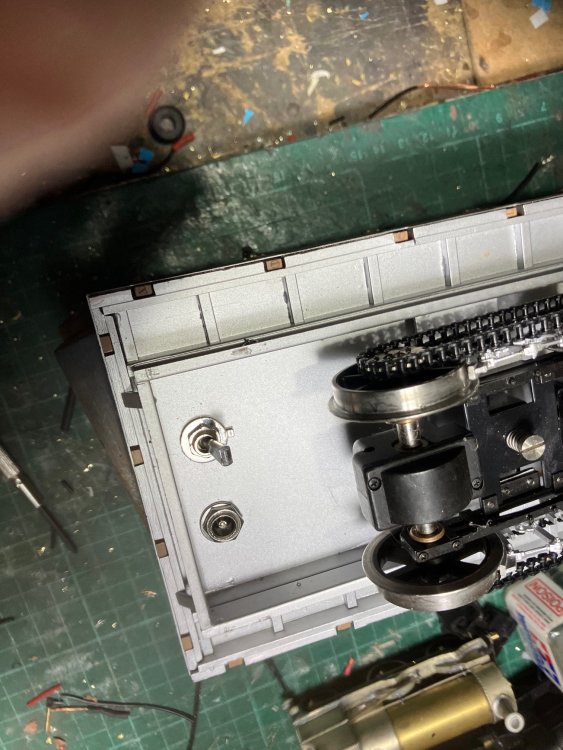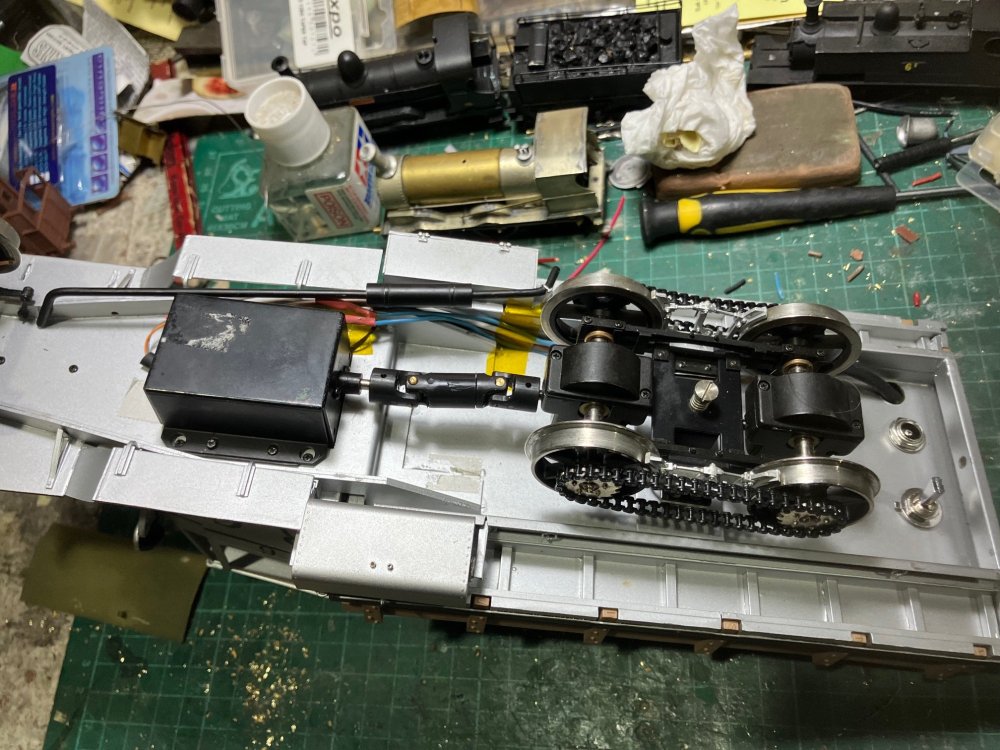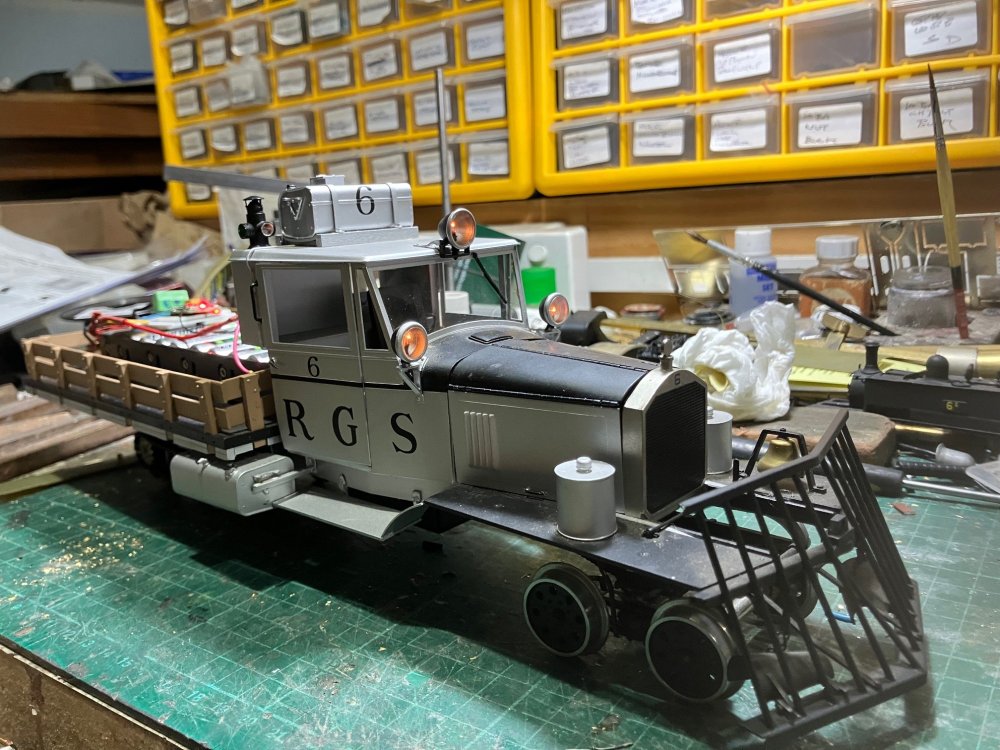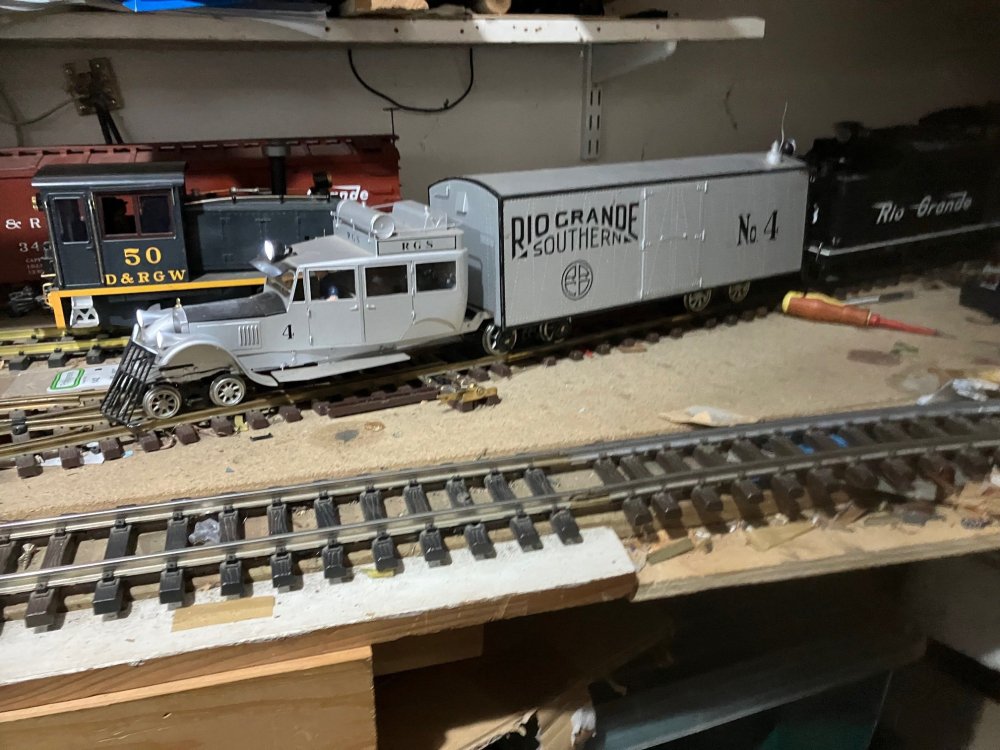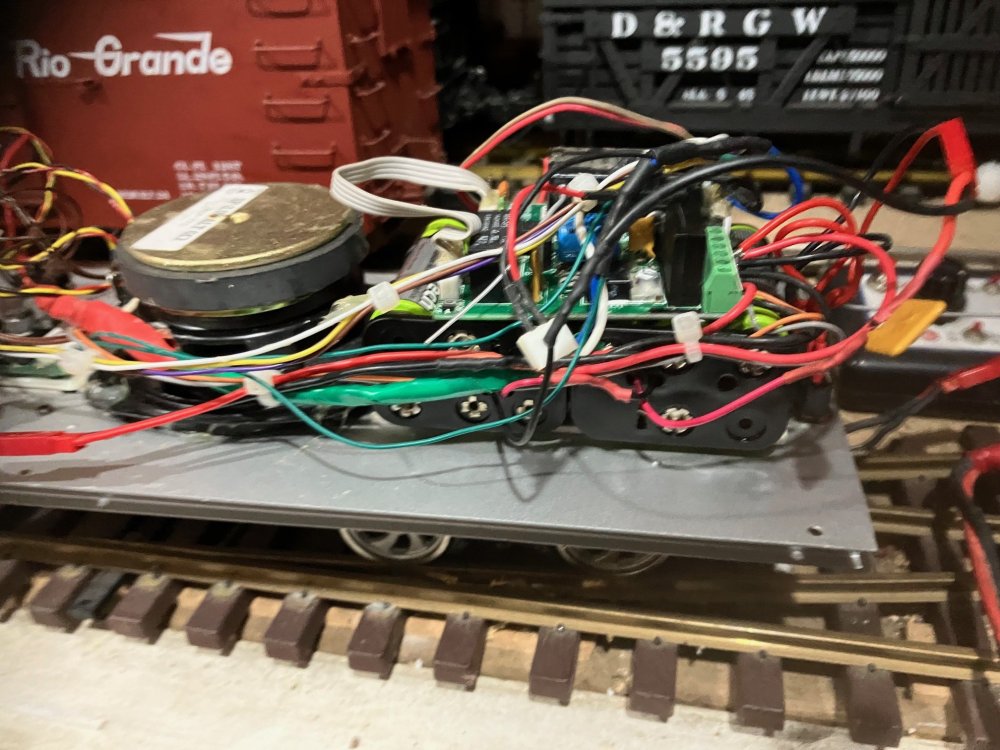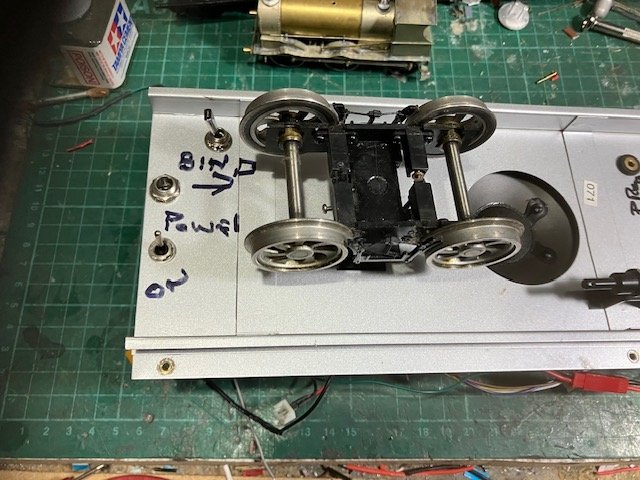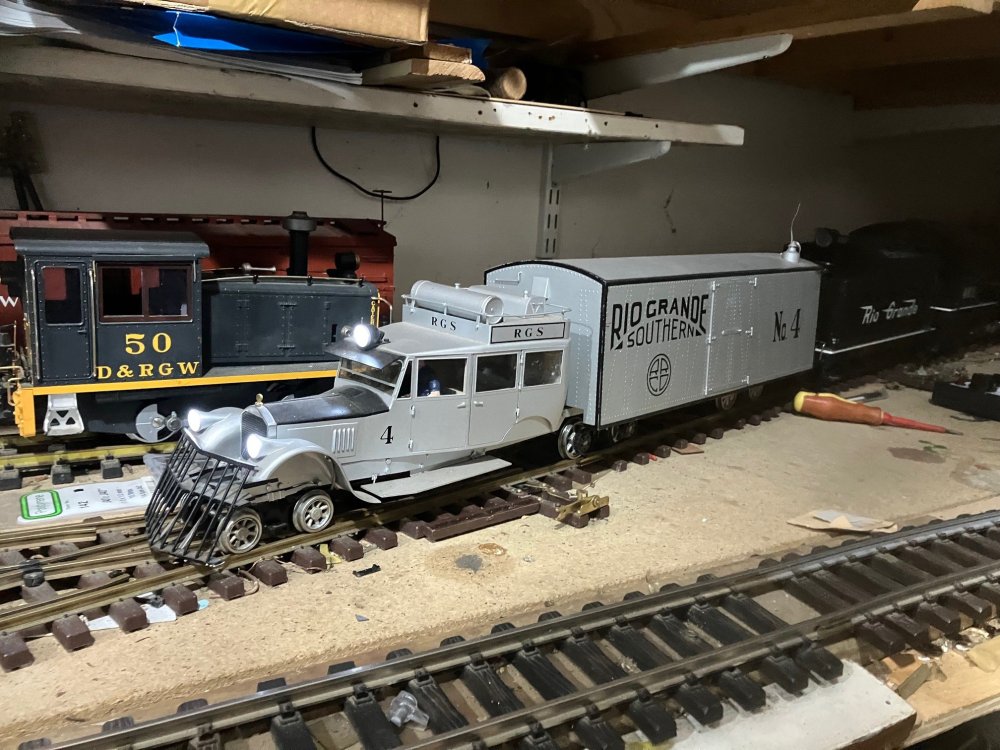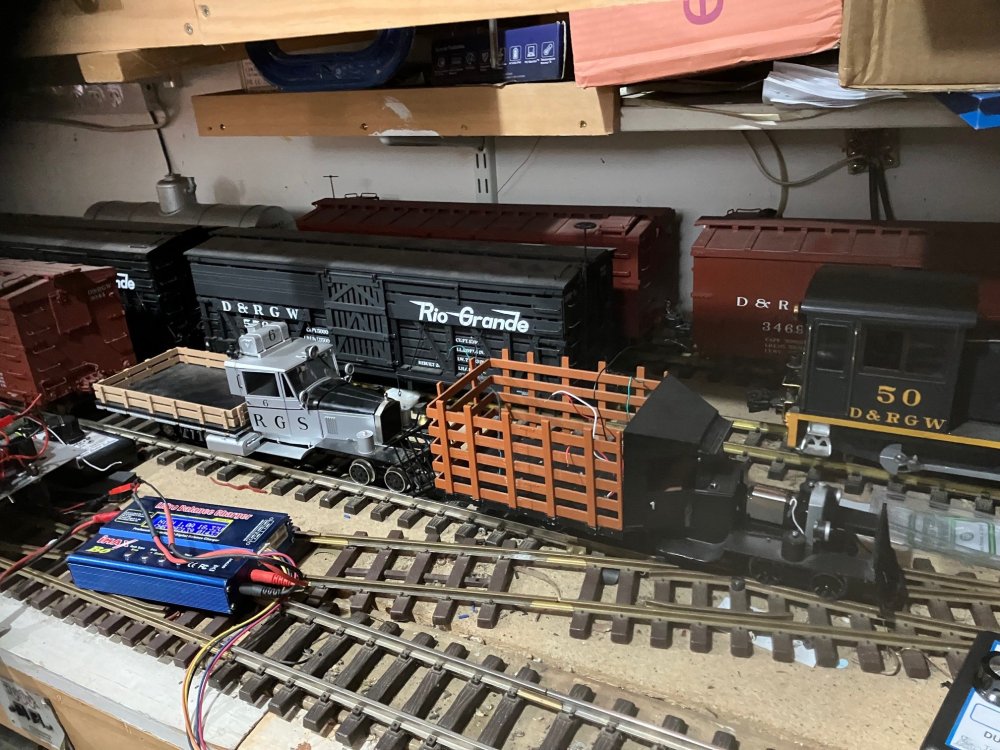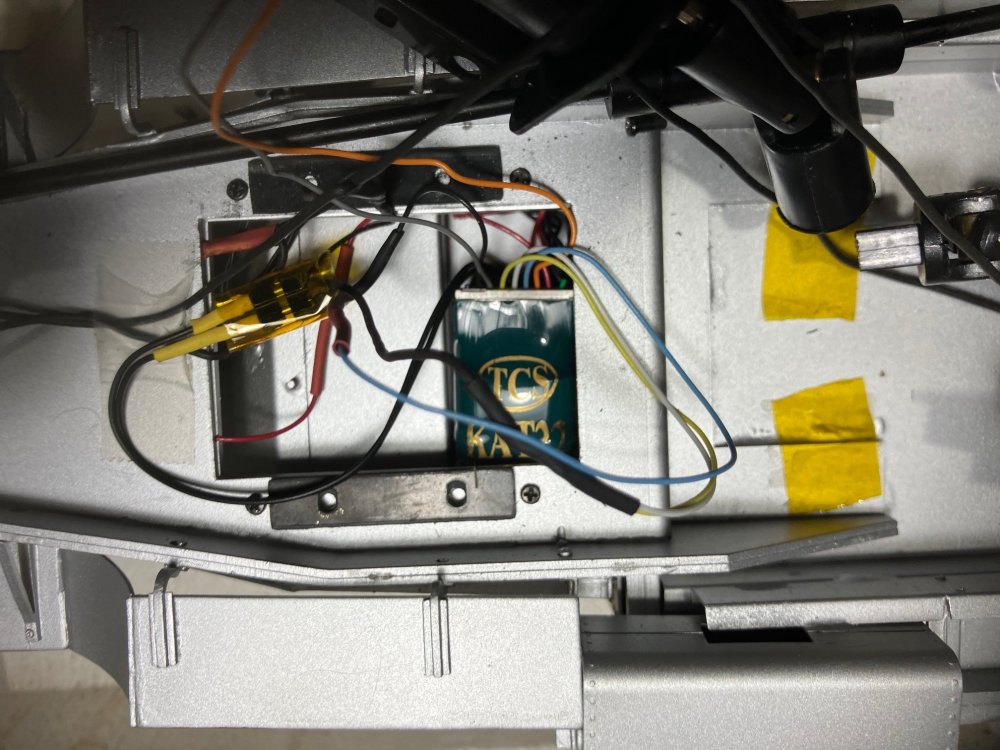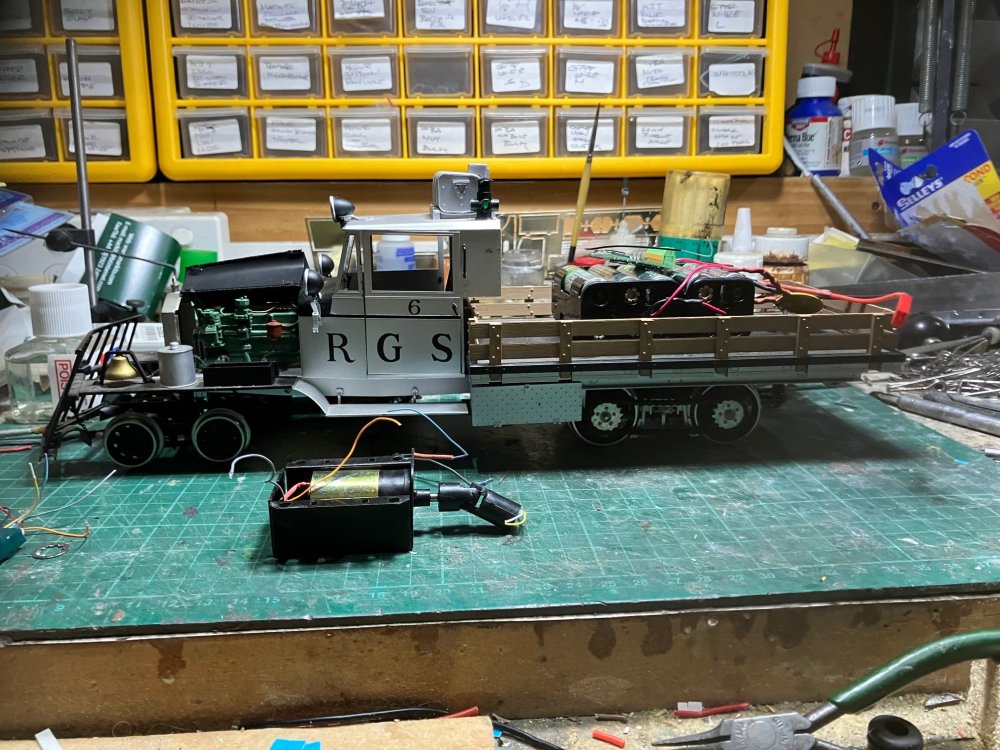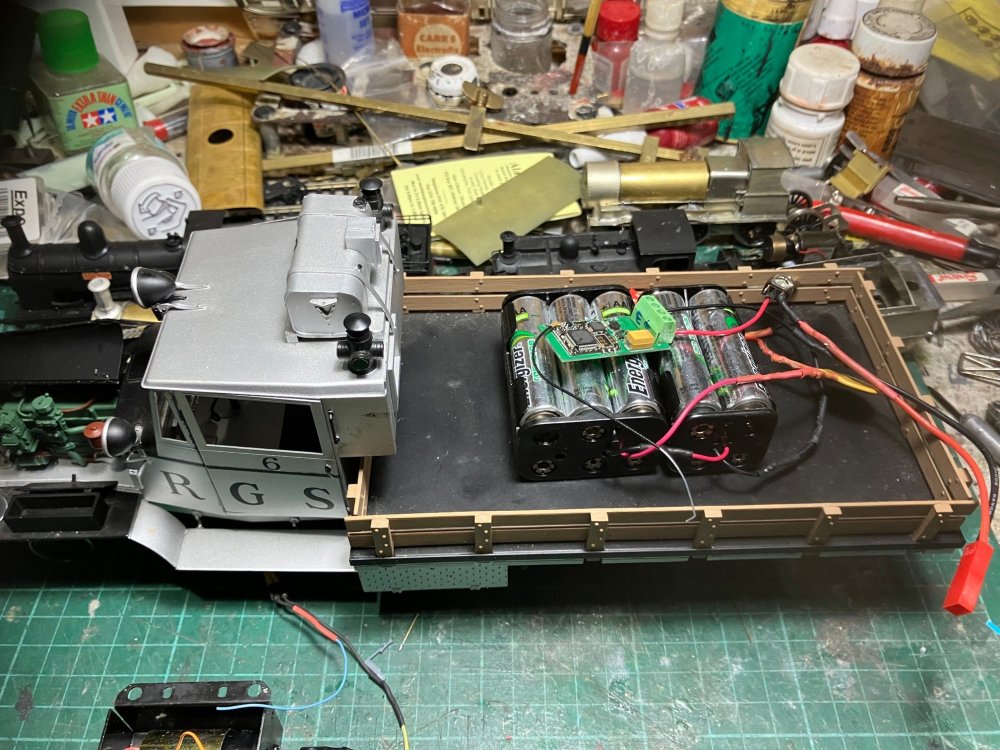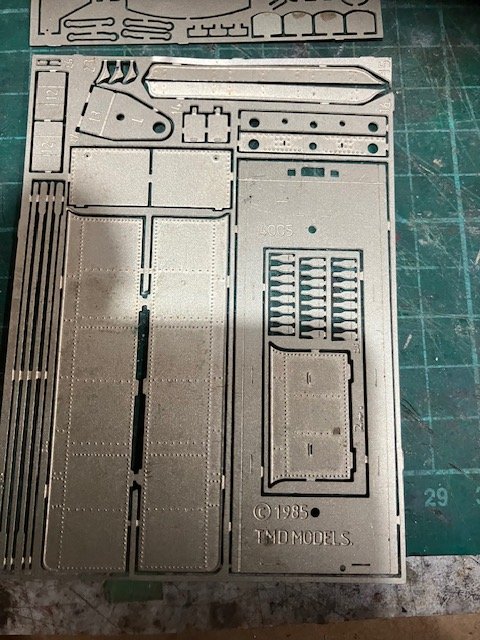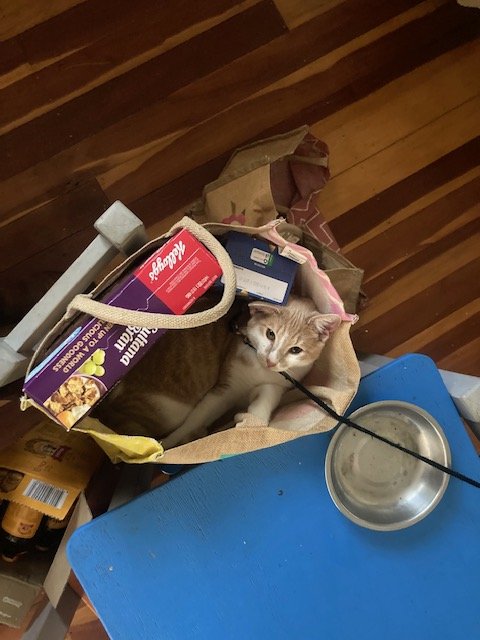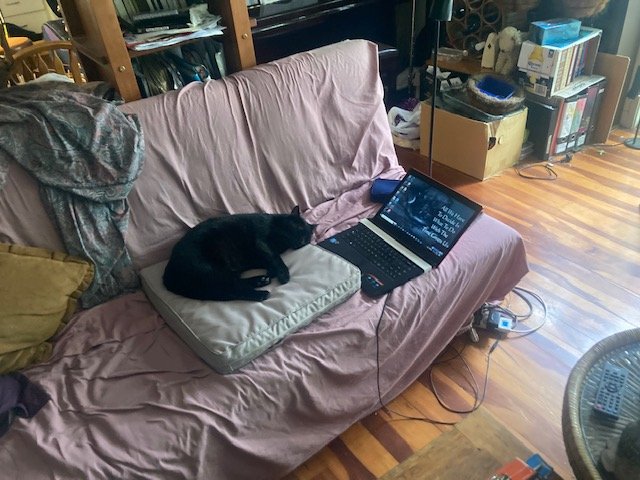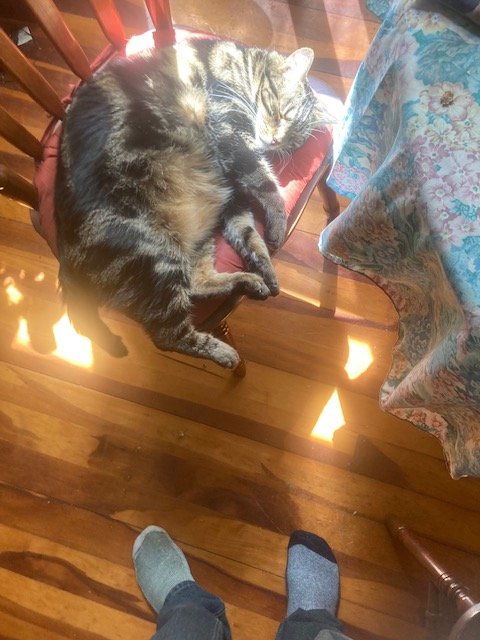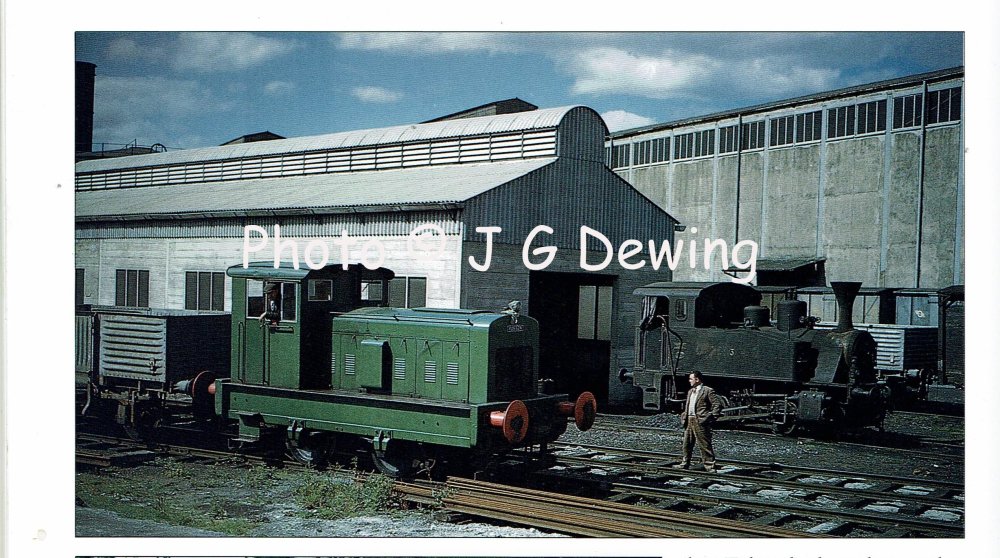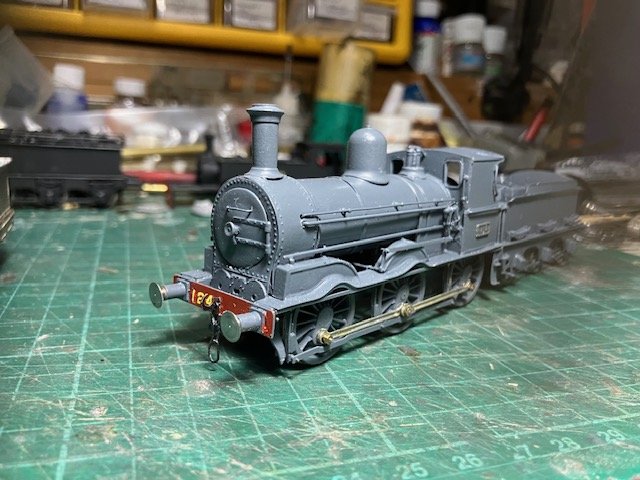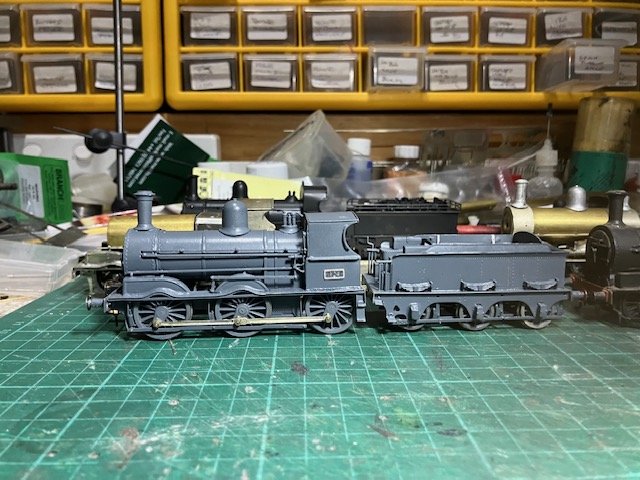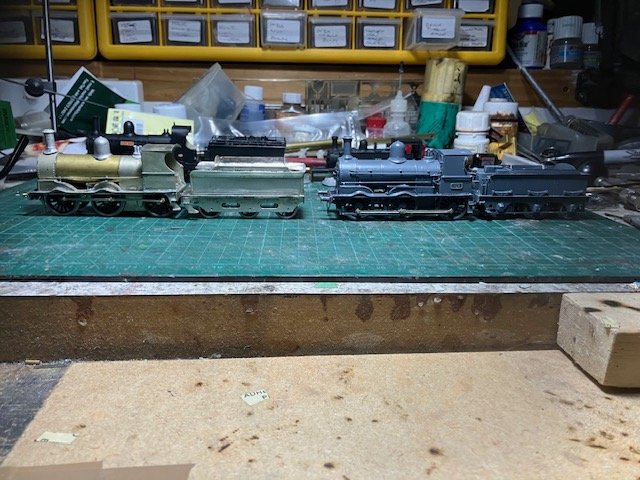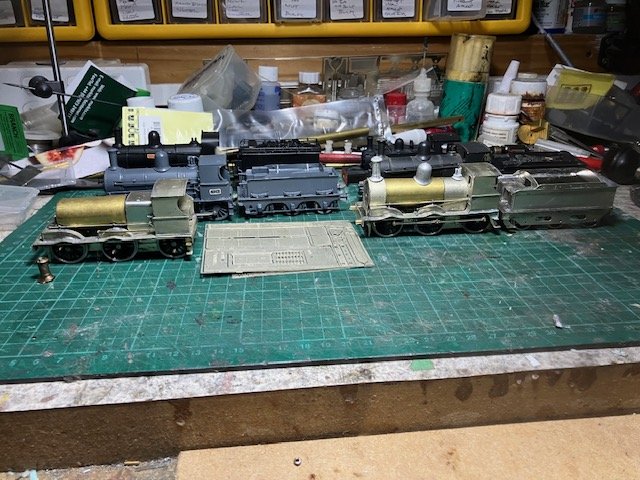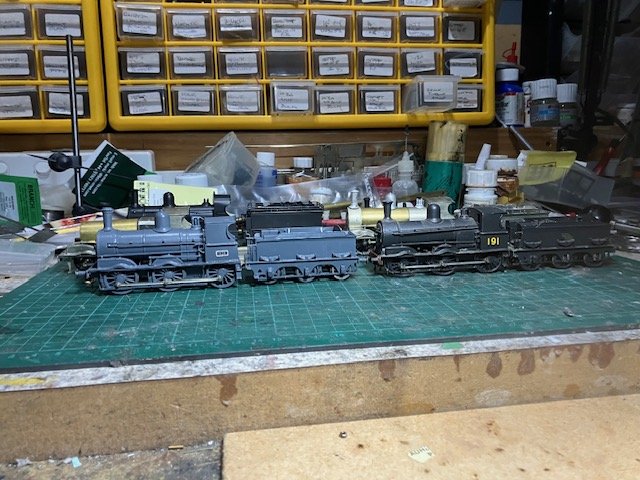-
Posts
4,880 -
Joined
-
Last visited
-
Days Won
119
Content Type
Profiles
Forums
Events
Gallery
Everything posted by Mayner
-
Sorry to hear about Dave, Junctionmad's passing my commiserations to his family and friends.
-
Completed conversion of Motor 6 to RC, wiring is a bit agricultural using existing stock. A flat 10 battery holder replaced the 6 & 4 in the last post. Tested the lighting with a temporary hook up to the receiver before installing the permanent wiring, as I was unsure if it was set up for directional lighting. The both the headlights and lamps on the cab roof are on a single circuit fed through a diode only lighting when the motor is moving forward. Receiver temporary set up, motor leads feeding the lighting. Charging Jack and power switch, large scale modellers are not too bothered about hands free operation Permanent hook-up receiver re-positioned towards the rear of the bed. Brown and white wires motor hook up, blue lighting the - lighting circuit is hard wired to a pair of solder pads (F1 & 2) on the receiver the + connected to the red on the terminal block! Receiver is mounted on double sided foam pads on a piece of plasticard to ensure receiver is isolated from power sources. The "receiver" includes integral RC receiver, power controller and function controls, similar size to a DCC chip. More wiring bodgery. I had to run the motor and lighting power leads from the rear of the truck cause the battery holder takes up most of the space on the bed. The universal joint end near the motor had split at some stage and is Lockset to the motor shaft. Motor 6 should be busy on track renewals during the next few months as I urgently need to replace the ties (sleepers) on approx 40+' of the main line that have failed after 16 years as a result of UV damage. Thinking of making up an inverted box to protect the electronics and as a base for a load.
-
The Bo-ness O Gauge Group appear to have received over £22,000 so far in donations to restore the layout after setting out with an initial target of raising £15,000. https://www.justgiving.com/crowdfunding/bonessgaugeogroup-modelrailway A donation to this appeal would be a good practical way for members of this forum to show their solidarity and support to the Bo-ness Group.
-
Non-violent offenders can be sentenced to between 40-400 hours "Community Work" in this part of the World. https://www.corrections.govt.nz/our_work/in_the_community/sentences_and_orders/community_work Track maintenance and renewals on our local heritage line (approx 5miles) has been carried out for several years by offenders sentenced to 'community work" under the supervision of a Ganger paid by corrections.
-
I was a member of the group that operated the MRSI 21mm gauge Loughrea Layout that regularly appeared at exhibitions during the late 90s early 20s. Although there 5-6 regular members in the group Brian Fennel and myself provided (an assembled) most of the locos and rolling stock. In the early days we found that 4 locos were adequate to operate the layout over a 2-3 day exhibition, though the loco stud later expanded. A pair of J15s (TMD/SSM kits) did the lions share of the work although we both had a pair of GNR S Class 4-4-0s (TMD/SSM). Other kit built and scratchbuilt steam (mainly GNR locos) were available but did very little work, 1-2 ending up usually parked around the loco shed I later added a number of diesels Model Irish Railways whitemetal bodies on modified Athearn chassis including a 001, 141 and pair of 121s Coaching stock was covered by Brian's 3 SSM GNR corridor coaches and later Brian's rake of SSM GSWR 5 wheelers (1 assembled as a MGWR coach), I provided a pair of re-painted/re-gauged Hornby Stanier coaches and later a 2 Car IE push-pull set converted from Lima MK 3 coaches. Wagon stock was about 30 or so vans and cattle wagons a mixture of Brian's scratchbuilt and my re-gauged and converted Parkside BR wagons. Another member of the Group Jim McGuire contributed a beautiful scratchbuilt ex- MGWR 20T goods brake. So to summarise two (reliable) steam outline and two diesels, a short rake of coaches and about 20 wagons were adequate for operating a branchline terminus layout over a long weekend. No mechanical problems to speak of with our kit built steam outline locos assembled from SSM kits, only problem was when I used a Labelle oil with insulating properties to oil the bearings with live axle pick up in preparation for an exhibition stages at the Inchacore Works 150 anniversary, though my 001 Class saved the day successfully working cattle specials without a problem throughout the weekend. Both Brian and I agreed that we spent a lot of time assembling kits that were in appropriate for the layout which would have been better spent scratchbuilding more appropriate ex MGWR locos and stock. With a through/crossing station on a secondary main line you are probably talking about a minimum of 6 locos and 2 sets of coaching stock and 30 or so wagons. Operated an N scale Irish secondary main line layout based on Sligo Line timetable about 40 years ago, found 4 diesels adequate to operate the service. Pair of 121s and 5 coaches on main line passenger service, B141 on the night Mail and daytime freight services and a 001 on the overnight goods. You would need another pair of locos and set of main line coaches if your modelling a station where the passenger trains cross en-route or the sets distinctly different. You would need an additional loco and rake of tank wagons if you decided to model the trice weekly Sligo ESSO oil train. Building an exhibition layout based on a through station on a secondary main line would involve a tremendous commitment in terms of space and time particularly if you intend to work to 21mm gauge and model the steam era. Difficult to achieve as an individual effort.
-
Have the Scottish Courts the power to sentence the perpetrators to work (possibly track maintenance or rolling stock restoration) on the Bo-ness and Kinneil Railway? Track maintenance on our local heritage line has been carried out for several years by non-violent offenders sentenced to 'Community Work" under the NZ Justice system. The Justice system pays an experienced Track Ganger to supervise the offenders. The programme seems to have been a success for the railway particular as the founders/regular volunteers are getting older/becoming elderly and no longer have the physical stamina to carry out track maintenance work. Several years ago one of our politicians was far sighted enough to realise that New Zealand's imprisonment rate was unsustianible , the literally the country could not afford to build or maintain the prisons required to house a growing prison inmate population and the money was better spent tackling the causes of crime and offender re-habilitation. One of the outcomes was the sentencing of non-violent offenders to "Community Work" and Trade Training of more serious offenders to reduce recividism. Inmates in the regions largest local prison receive training in trades which are in high demand and even employment while in prison. https://www.corrections.govt.nz/about_us/getting_in_touch/our_locations/spring_hill_corrections_facility. Being inside not really a barrier to employment in construction, forestry, agriculture or heavy engineering if your a good worker and have moved on from crime. I am fully in agreement with Ironroad on tackling the causes of crime and my distaste at politicians who exploit peoples fear of crime to get votes while failing to address/acknowledge the root causes.
-
Possibly a line on a viaduct from the station until it reached the higher ground North of the river towards the hospital. Interestingly the station building seem to be to the south side of the station with apparently a blank wall behind the buffers. Sligo in the Victorian era would have been pretty compact as a city, the Merchant Princes and local Gentry/landowners would have had a lot of control the final say. Would have been challenging to locate a line that would avoid the city centre apart from going via Manorhamilton on account of the short distance between the city centre and Lough Gill. A coastal line to Bundoran and possibly on to Donegal Town might have possibly survived as an extension of Dublin-Sligo services.
-
Though I would keep my Large Scale stuff on a different thread to my Irish small scale stuff. Started tracklaying o the garden layout shortly after we moved to our present home almost 17 years ago so a lot of maintenance required at this stage if the Jackson County is to stay in operation. The first owner when our home was completed almost 100 years ago was a Jackson and have Jackson family connections. First job was to get RGS Motor #4 running again in order to keep the Mail contract and the railroad open. Motor 4 was bought second maybe third hand eight years ago from UK used equipment dealer Ellis Clarke Trains for £600 plus GST (VAT, Duty and NZ Customs fees) Motor 4 was supplied as a non-runner wired for battery RC and retro-fitted in the shops with sound and possibly a RCS (Remote Control Systems) receiver-power controller. #4 gave good service but like the Drumm Battery Trains of the 1930s the (NiMh) batteries require replacement after nearly 8 years service! #4s new batteries (10X1.2V 2300mAh) are partially hidden under the rats nest of wiring and the radio receiver-power controller. The receiver-power controller was supplied by RCS owned by the late Tony Walsingham in Australia. Large scale battery RC equipment is was largely a cottage industry business with RCS supplying equipment internationally. #4 receiver transmitter used a Spektrum 27Gh receiver widely used in model aircraft in combination with RCS circuit board and power control unit. Its only in recent years that miniature combined receiver-power control boards became widely available similar in size to a HO DCC decoder. One puzzle re-assembling #4 was the purpose of a pair of brown and red leads on the receiver board. No wiring diagram in the instruction manual and the RCS archive no longer accessible after the business closed after Tony passed away. Managed to find a wiring diagram on YUMPU likely to be for 'binding" the receiver to the transmitter, but had that "lightbulb moment" when I looked at the underside of the model. The wires were for a binding switch to allow #4 to be bound to a transmitter without having to remove the body! Basically in order to operate a receiver has to be 'bound" to a particular receiver, the binding switch allows #4 to be bound to different receivers similar to but cruder than selecting a particular loco address to a DCC throttle. Took over an hour to charge #4 batteries for 1st time use followed by test, re-assembly and post assembly test that everything is working correctly. Yes the radio antenna is intended to stick out of the body through a hole by the tail light, to avoid problems with poor radio reception as a result of the all metal van body. Next vehicles to be returned to working order were RGS Motors #1 and #6. Motor #1 is a Bachmann Railtruck & Motor #6 is a Berlyn Locomototive Works Korean Brass model acquired from a US dealer in 2016, both had been track powered and had not operated since track power operations had ceased several years ago. The nylon final drive gears in the Bachmann railtruck had split several years ago and replaced with lost lost brass castings of the orignal gears which appeared to be ok. Although the real #1 had been dismantled and parts re-used in #6 I though it would be nice to have both Motors in operation on the Jackson County. Unfortunately there were meshing problems with the new brass gears under test so Motor #1 may be retired to a display case (not really practical to have a spur for dumped/dead stock on a garden railway! Preparing #6 for conversion to battery RC revealed a few surprises, I had converted the motor to DCC complete with a 'stay alive" decoder. Also the electronics for the lighting (incandescent) are on a separate module. Assembly is unusual because the motor is mounted on rubber mounts on the underside of the chassis. Planning to power #6 with 10 AA NiMh cells from a stock or re-chargable batteries bought several years ago in the RGS second hand/junk yard tradition. Mock up of batteries control circuitry #6, motor drives on the rear bogie Motor #6 seems to have been used for PW work and light switching, try a flat 10 battery holder to lower the profile of the load. #6 seems to have been used for carrying ties (sleepers) or the bed covered with a tarp. Its a fine and delicate model with a low top speed in comparison with Motor #4 and the locos.
-
Company I served my time with used T&G chipboard for flooring several hundred houses in Dublin, used to be receive an artic load direct from Munster Chipboard (Waterford). Stored outside sometimes uncovered for several weeks/months before being installed, never had any comebacks or complaints from buyers. Replaced a ground floor and carried out damp repairs in a Dublin Artisan's cottage as a casual job about 40 years ago. A young nurse working in a local hospital bought a cottage renovated by a gang of Ludraman's, who had replaced the existing t&g flooring with chipboard and plastered the exterior walls in sand and cement blocking up the air vents. Chipboard and joists were not in to bad of a state when I priced the job, but a section of floor literally collapsed under me when I stepped into the cottage to talk to the client when I got the go-ahead to start about 6 months later. Underside of chipboard and joists were literally covered in a white mould/rot.
-
Shouldn't really have gone there Ivan. Feral is considered in Australasia to be a counter-culture a development/amalgam of the hippy and punk movements something I would subscribe to rather than what I see as 'a Moral Panic with youth crime and immigration stirred up by the media and populist politicians in many parts of the World including New Zealand, Australia, the States, Britain and Europe. New Zealand crime and culture. New Zealand is no south sea paradise we have the second worst adolescent suicide rate in the OECD, a high imprisonment rate compared to OECD average, high proportion of prison inmates (40-50%) untreated mental illness. Lot of moral panic over youth and gang crime in recent years although crime rates been decreasing over the past 30 years. Youth and gang crime visible, 16 year old murdered by a 13 year old at a city centre bus station this week, highly visible US/Australian style street/biker gangs involved in violent and organised crime. Supposed to be more gang members that cops these days. Moral panic. I see a feral culture more in terms of politicians and the media exploiting peoples fears and prejudice to get elected/take power rather than tackle the root cause of societies problems, as happened in Nazi Germany and appears to be happening in many Western countries. Recently a centre right coalition Government was elected in New Zealand in which the minority partners obtained the balance of power by exploiting moral panic among older white voters about crime, immigration and the perception of preferential treatment for Maori (indigenous New Zealanders) and their culture. Ironically several of the political leaders stirring up anti Maori sentiment were Maori but it bought white working class votes. Not a lot different from a politician with a Basque name a MEP with a German wife stirring up UK Nationalist sentiment which ultimately lead to Brexit Much of the prejudice about immigrants was that wealthy immigrants particularly from Asia were pricing New Zealanders out of the housing market, rather than supply not keeping up with demand and rampant speculation driving house prices up. Prejudice I gradually overcome my own innate and learned prejudices by meeting and getting to know people of different races, cultures and social cultures during my working life leaning that keeping religion and politics out of it there was little difference between us. I also learned about 20 years ago that there was no point in arguing with a person with entrenched views in this case the Alf Garnet or Archie Bunker of our family an uncle who was ranting on that all Nigerians were involved in scams and or organised crime, but had never actually met a Nigerian. My uncle got quite wound up when I told him that I knew several Nigerians (from working in UK and Ireland) who were honest upstanding people. Going by the principal that your stuck with your relatives but choose your friends. I stopped associating with several so called model railway friends that worked themselves into a larther over single mothers on benefit and immigrants 'making a mess" (dumping) in New Zealand. Apart from not being able to think of a better topic of conversation, I quickly realised I had little in common with either group. One of the ironical things was watching a single male in their 20s encouraging a group of older-elderly middle class women in their moral outrage at single mothers. I got quite annoyed when a so called friend spouted prejudice about immigrants in my home in front of my young daughter, but he frankly could not accept when challenged that a New Zealander (a Kiwi) would or could dump rubbish by the roadside. So in the end it all boils down to what a person perceives as a "feral culture', I would perceive as some of the comments on this thread as being signs of feral culture, where apparently two frustrated burglars vandalised and set fire to a carriage at Bo'ness rather than teenagers getting their kicks Some of our neighbours on the street in Crumlin where I grew up 40-50 years ago were burglars and petty criminals and vandalism/malicious damage to public amenities was quite rampant, so nothings really changed apart from the War on Drugs having contributing to a drug epidemic and turf wars among criminal gangs in most countries
-
While I have sympathy towards the volunteers who worked on the layout, I am disappointed but not surprised by the race to the bottom in dreaming up the most cruel and unusual punishment for the perpetrators. After all it was wise Iain Rice that said model railways was a pointless hobby that served no purpose. Vandalism, looting, burning-destroying coaches on preserved railways is an age old problem I have largely become a lone wolf in recent years (apart from this newsgroup) as a result of extremely intolerant opinions expressed by former modelling friends (everything from racism-through antigun control-to un-married mothers). I chose my friends and ignore the crap on social media. Going back to LNERW1 point about not coming out about model railways. Model railways have traditionally been looked down on seen as nerdy (at least in Ireland) often by parents. I got my first proper Triang-Hornby train set at 13 almost as an act of teenage rebellion my parents and aunts and uncles who hoped that 'I would "grow out" of model trains and take up more manly interests and never really adjusted to my continued interest as an adult, at 67 my inlaws/wifes friends laugh/smile when my interest in trains is mentioned- but have long ceased caring. Funnily enough no problems mentioning my interest in model trains, in early teens most class mates were mainly interested in soccer although we went to a school with a Gaelic tradition. Couple of classmates that were interested in trains moved homes/changed schools when we changed to secondary school, possibly leaving me the one person interested in trains in our class. Group that accepted me/hung out with sometimes spoke about my interest in trains, being more nerdy/academic I was accepted allowed to hang out with a group of 'cool rich kids" and invited to their parties as we progressed through secondary school. Probably closest to a dark haried Garreth in Waynes World who also played with trains
-
Good luck with the move Patrick and Maureen, I can identify both with your caring commitments and having to dismantle a layout as a result of a house move. It was great seeing a classic American style walk-around layout in a South Waterford context a single track main line railway through rolling country with high viaducts and tunnels. Ironically I was struck by the railway around the headland at Ballyvoyle and the level crossing in Dungarvan when I first visited the area as a 7-8 year old 60 or so years ago in the back of my parents car travelling from Waterford to Youghal, the Sun was so strong my Mum bought me a Cowboy hat in Youghal which I proudly wore for the rest of the holiday. Also pleasing to see my 3D printed wagons and vans in real goods trains
-
Very sorry to hear about Ken's passing, please pass on my condolences to his family.
-
I have bought several items from Ellis Clarke Trains down the years, no vat charged on orders exported outside of the UK.
-
Can't beat animals for common sense! My dad had a story about the way a fox would take a bath in a river with a small piece of wool in his mouth when he had a flea problem. Fox would gradually submerge himself until only the tip of snout and piece of wool was above water and the fleas would take to the piece of wool as a lifeboat as the fox submerged his nose and the piece of wool floated away!
-
Traditionally a small Irish branch line terminus would have relatively little in the way of signalling, a Fixed Distant about 1/2 mile out a Home Signal to allow trains to run into the passenger platform and a Starting Signal to allow trains to depart from the platform into the next section. Points on passenger carrying lines are connected to a lever frame in the signal box, all other points usually hand operated. Disc-signals were used to control shunting moved to and from a passenger carrying line. Beagnach End is unusual for an Irish branchline terminus in the the loco release crossover is on a passenger carrying line, on most Irish branch terminals the loco release was located past the end of the platform and hand operated. I have drawn the diagram with the points normally set for the platform road. In full size practice facing points on a passenger carrying line were fitted with a point lock operated by a separate level, though where an "economic lock" was used point and loco could be controlled by the same level. In full size practice movements from the main-line to the yard were sometimes controlled by a hand signal, though sometimes a disc or short arm was fitted to the Home signal, likewise the signal controlling movements from the yard to the main line could be a disc or a full size signal. In colour light/power signal practice 2 aspect signals would be used in locations like this with miniature shunt signals replacing discs and points controlled by point motors either controlled from a local cabin or the CTC in Dublin
-
Yep: It looks like its the SSM version of the J15 Kit SSM continued to used the original 1985 tooling for the etched parts, main difference between TMD & SSM versions seems to be the replacement of the original turned brass chimney and dome supplied with the original TMD version with a comprehensive set of whitemetal castings, the change in the frame spacers from square section brass to turned brass spacers and the etched parts produced in nickel silver at some stage during the past 30 years.
-
Most senior cat gang boss Beeze (ex animal rescue) prefers to sleep and let less senior cats do the work Second in command Grey (walk in stray) the brains commands operations on the dark-web. Most junior member of the gang Topaz (another stray)who acts the young-punk occasionally challenges the others checks out the groceries. We have another older guy Gramolkin (yet another stray) quite camera shy who probably acts as a silent enforcer who only appears at breakfast and supper time. The four guys seem to get on well together and share territory though Topaz being the youngest member of the gang occasionally challenges Beeze to a wrestling match before submitting. Mice and rats keep a very low profile in our neighborhood.
-
Have a look at the instructions. There is a 1993 amendment that refers to ex TMD kits which include a note that the mouldings for the tender axleboxes and springs are included with the J15 kit. The bag of castings looks similar to the castings supplied with a pair of J15s kits I bought from SSM in 2007-8.
-
Possibly two kits the original 1985 TMD and Studio Scale Models (Paul Greene) versions. I have built both the TMD and SSM versions of the J15 Kit durin the past 30 years. The original TMD kit was etched brass, with square section frame spacers , brass tube boiler, turned brass chimney and dome and Slaters tender axleguards and springs. The SSM version was in etched nickel silver, boiler rolled from brass sheet, whitemetal castings including boiler fittings, smokebox door, tender axleguards and springs. What's in the unopened bag between the castings, pre-formed boiler-firebox and instructions? Reminds me of the time about 20 years ago I bought what I thought were 6 part and unbuilt TMD kits at a UK exhibition and found that I had actually acquired 7 kits.
-
Carlow Ruston 1960. Points to note CSE Rustons were operational approx 30 Years RPSI Ruston has been in preservation for over 40 years! No standard CSE 'livery' as such each plant had its own 'style" sometimes locos at the same plant painted in a different 'style" possibly depending on maintenance staff/painters personal taste. CSE plants were large installations challenging to model in 4mm with large marshalling yards and large processing plants, not really suitable for a lineside industry on a shunting plank, typical 17-18'x8' garage or loft conversion. Would need several hundred opens and 50 or so vans to model convincingly
-
I have a 21mm gauge 88DS built from a Impetus kit about 25-30 years ago, Etched construction not dissimilar , so Judith Edge kit likely to be re-gaugable to 21mm gauge. Livery was based on the RPSI as preserved CSE loco from memory Superstructure (Cab & Bonnet) Medium green, chassis and buffer beams black buffers red. Gold "Cómhlucht Siúicre Éireann" on the side of the bonnet above the access panels. There is a 1960 photo of an all green 88DS with red buffers alongside O&K steam loco 3 at Carlow. The 88DS appears to be all green apart from red buffers (including heads), grey head lamp housing and "Ruston" plate whitemetal letters and surround, black background. Strangely there is no RH plate on the cabside. Threatening for some time to fit my 88DS with a modern High-Level mech, Mine has an ancient Tenshodo open frame motor which drives a pair of 1:1 brass gears which power a layshaft that drives a pair of 30:1 Gibson brass gears, whole arrangement extremely slow and noisey.
-
You need to connect each of the 3 oval tracks to the Zephyr, either by loops from the 1st track or wired directly to the Zephyr. An important factor to remember is that the power feed should be at the toe rather than at the crossing end of the point otherwise the power to the section may be switched off when you change a point. Unfortunately there is a bit more to DCC wiring than two wires from the controller to the track, there are some useful on-line resources including https://4dpnr.com/wp-content/uploads/2015/07/DCC_Wiring.pdf
-
The 'Grey Engine" has finally found her identity after 20 odd years as 124! I had plates etched for 124 & 181 several years ago bit could not figure out which engine! According to Locomotives of the GSR 181 built 1879 was rebuilt with new frames and a superheated boiler in 1937 while 124 built 1881 soldiered in in saturated from until rebuilt with a superheated boiler in 1948, so the "Grey Engine" became 124 and the 'superheated" engine will be completed at 181. Basic assembly 229s tender complete, I got to fit the brake gear to loco and tender before carrying out the final detail work. Dusted off 181 which will run with a 1804Gal tender, found a suitable chimney in my stock of parts but still have to locate the smokebox! At this stage planning to keep 4 J15s including 191 assembled approx. 30 years ago and retire 193 1st assembled approx. 40 years ago, time flies! The MGWR 2-4-0 "Arrow" (OO) is due some paint touch ups, 124 a coal load and 191 replacement tender axleboxes and dusty removal before the trio return to their display cases.
- 58 replies
-
- 10
-

-

Limerick to Foynes railway reopening plan
Mayner replied to spudfan's topic in What's happening on the network?
Government/NTA willingness to fund a rail service from Adare to Limerick including the cost of obtaining Office of the Rail Regulator authorisation to operate such as service. https://www.crr.ie/safety-regulation/authorisation-to-place-in-service. It looks like the NTA is responsible for planning and funding 'sustainable' transport projects in Limerick, a practice which is different to most Western countries where Cities and Regional Councils are responsible for planning and funding public transport. https://www.nationaltransport.ie/planning-and-investment/. Presumably in order for a passenger train to operate a line would have to meet the Irish Railway Standards published by the ORR https://www.crr.ie/publications/irish-railway-standards/. In the old days specials operated on freight only lines like Drogheda-Navan that were still 'passed' for passenger operation, basically where platform, track and signalling met the requirement of Railway Regulations in force since the 19th Century
.png.c363cdf5c3fb7955cd92a55eb6dbbae0.png)

